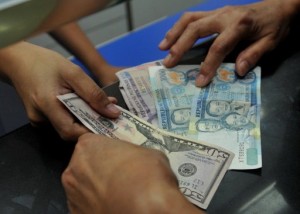
STRONG FINISH. A woman exchanges Philippine pesos for dollars at a money-changer’s stall in Manila on November 5, 2010. The peso climbed to the 41-to-a-dollar territory on Monday to mark its strongest finish in over three years. AFP PHOTO/JAY DIRECTO
MANILA, Philippines—The peso closed at the 41-to-a-dollar territory on Monday to mark its strongest finish in over three years, as the US Congress moved to raise the debt ceiling of the world’s biggest economy, thus preventing it from defaulting on its loans and boosting even emerging market currencies.
The peso ended Monday’s trading at 41.925 against the US dollar, hitting its highest end-day value against the greenback in over three years, or since April 21, 2008, when it closed at 41.87.
Monday’s close was up by 21.5 centavos from Friday’s finish of 42.14:$1.
Intraday high hit 41.90:$1, while intraday low settled at 42.10:$1. Volume of trade inched up to $899.30 million from $844.87 million previously.
Traders said the agreement reached on Monday morning by US legislators to increase the debt ceiling finally gave relief to investors, who have been concerned about the possibility of a US debt default.
The US government had an August 2 deadline to raise its debt ceiling, otherwise it could have defaulted on its maturing obligations. Raising the debt ceiling was necessary so the United States could borrow some more and use the proceeds to pay off its liabilities.
US Congress had been debating for months over whether to raise the debt ceiling or not, eliciting fears that the deadline might not be met. With pressure from the White House, Congress finally agreed on allowing the Federal government to borrow some more.
Given the role played by the United States in steering the world economy, a default by it could disrupt financial markets worldwide. Emerging Asian economies like the Philippines are expected to be hit as well, given that a significant portion of their foreign exchange reserves are invested in US Treasuries.
In the case of the Philippines, the Bangko Sentral ng Pilipinas has admitted that the bulk of the country’s $69 billion in gross international reserves (GIR) is in US Treasuries.
GIR determines a country’s ability to meet its foreign currency-denominated obligations, such as debts owed to foreign creditors and importation. GIR is thus a closely watched economic indicator and one of the determinants of a country’s credit-worthiness.
Traders said the increase in the US debt ceiling eased concerns over the stability of the global financial market and global economy.
In times of uncertainty, traders said, foreign portfolio investors would normally withdraw and liquefy their investments, with investments in emerging-market assets being the first in line. During such times, they said, investors would prefer to be liquid by holding on to US dollars.
On the other hand, when markets are calm, investors tend to have more risk appetite and buy more portfolio assets, such as stocks and bonds, from emerging economies like the Philippines.
The appreciation of the peso on Monday came with an increase in investments in the Philippine stocks.
Meanwhile, BSP Governor Amando Tetangco Jr. said on Monday the peso’s appreciation was a general trend so far seen this year and a trend that could be sustained at least over the short term.
He said the relatively strong peso was brought about by a generally favorable sentiment of foreign portfolio investors on the Philippine economy and higher interest rates here compared with those in industrialized countries.
“The peso is affected by the positive sentiment for the Philippines and other emerging markets, and the general weakness of the US dollar,” Tetangco said.
Compared with industrialized countries in the West, emerging markets in Asia are growing more robustly and are expected to again lead growth of the global economy this year as they did last year.
The Philippines is estimated by its government to grow by 5 to 6 percent this year. The projection is a deceleration from last year’s 7.6 percent, but is much higher compared with the US growth rate of less than 2 percent.